Same Old Microsoft?
A dear friend of mine who likes to tease and criticize my company sent me an e-mail over the weekend with the subject line of “Same Old Microsoft”. In his message was a link to an article at PC World:
Make Firefox the Default Browser (Again) After Installing Internet Explorer 8
“Sneaky, sneaky Microsoft! When I agreed to install Internet Explorer 8 as part of a recent Windows update, I did not agree to make it my default browser. In fact, I wasn't even asked.”
The article goes on to explain that the author’s default browser was switched to IE8 and then lists out steps to switch it back to Firefox.
The insinuation of my friend’s email was that Microsoft was underhandedly taking over people’s computers and setting IE8 to be the default browser upon installation. Normally, I have a chuckle at such claims. Pretty much all browsers attempt to ‘automatically’ take over and become the default browser when they install themselves. Surely this is an example of the pot calling the kettle black?! However, the author of this article took things a step further by claiming that he wasn’t even asked if he wanted IE8 to be his default browser. How evil!!!
Knowing this not to be true, I decided to do a bit of my own comparison tests. I think my discoveries are worth documenting here.
In order to do this, I un-installed IE8 on my Vista machine and set Firefox to be my default browser. I then rebooted, confirmed Firefox was the default browser, and installed IE8. During the IE8 installation, the installation wizard does NOT ask you if you want to set IE8 as your default browser. The author of the PC World article was correct here! When the IE8 installation wizard completes, it requires a reboot.
After installing IE8 and rebooting my machine, I checked my default programs settings in the Vista control panel:
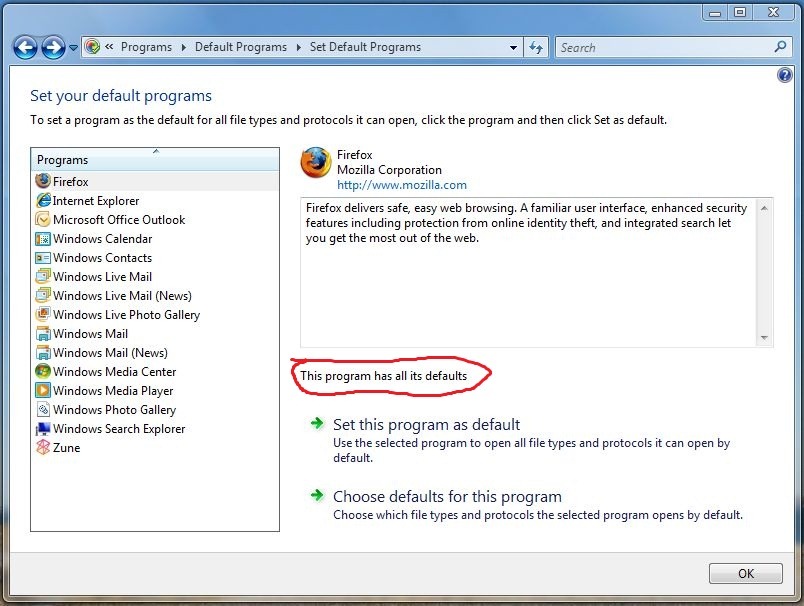
As you can see, installing IE8 had no effect on Firefox being the default browser! Apparently, PC World was incorrect here.
When you go to run IE8 for the first time, you get a dialog that asks you if you want to “use express settings” OR “choose customize settings”. Note some things about this dialog and remember them for later…
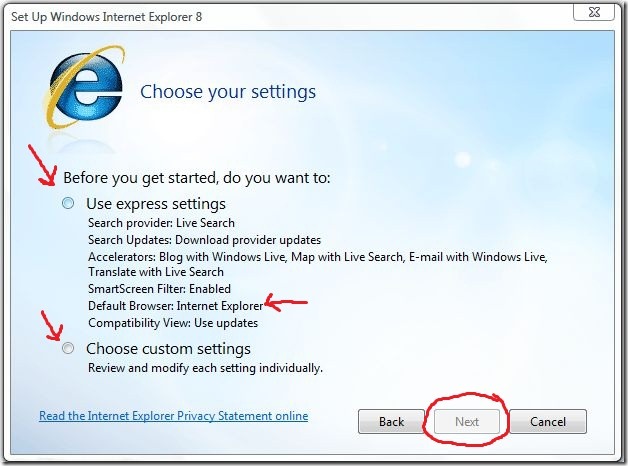
Look at the arrows. There is NO default setting on this dialog box!!! That means there are no “drive-by” setting changes.
Note: If a user simply clicks “enter” over and over to accept the default settings in an installation dialog, then gets unexpected or unwanted changes, I generally refer to that as a “drive-by” installation or “hi-jacking” of settings.
As a user, you need to make an explicit choice here before you can even click the “Next” button. In fact, if you don’t select anything and just click “enter” unwittingly, it will go BACK to the previous step in the wizard! If you do explicitly select the “use express settings”, it clearly calls out that it will set the default browser to Internet Explorer. Nothing nefarious there.
Now, let’s take it a step further. If you DO select “choose custom settings”, then on one of the next screens you see this:
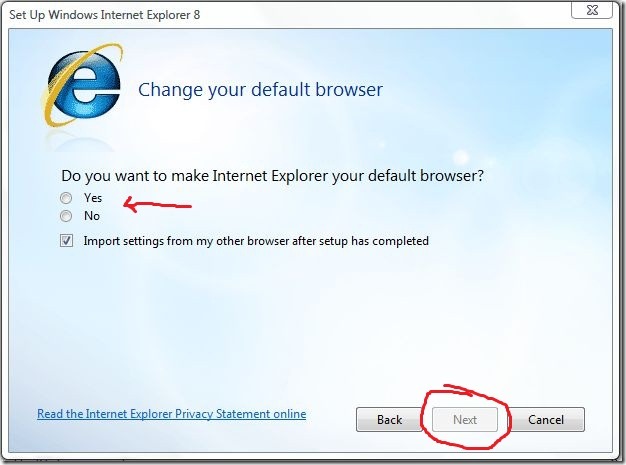
Same thing here. Note that there is NO default setting. You need to opt-in and explicitly choose a setting before moving on. If you don’t, the dialog actually takes you back a step!
If anything… I think Microsoft is actually making it HARDER for you to set IE as the default browser!
Update: Looks like the PC World reporter had admitted his error:
Update: Okay, I'm partially responsible for this. When installing IE8, I chose Use express settings , which, among things, makes IE the default browser. It says so right in the setup window (see below) , but I didn't pay close enough attention. Ironically, I usually opt for "custom/advanced" installations, but here I stopped reading after Search provider: Google . Anyway, for all intents and purposes, Microsoft did "ask" before making IE8 the default browser, just not in the usual way. My apologies for any confusion.
Now, let’s see how this compares to the competition. In order to do this, I installed a copy of Google Chrome 1.0, Safari 4 Beta, and Firefox 3 on my fresh Windows 7 RC install.
When you install Google’s Chrome, you get the following dialog:
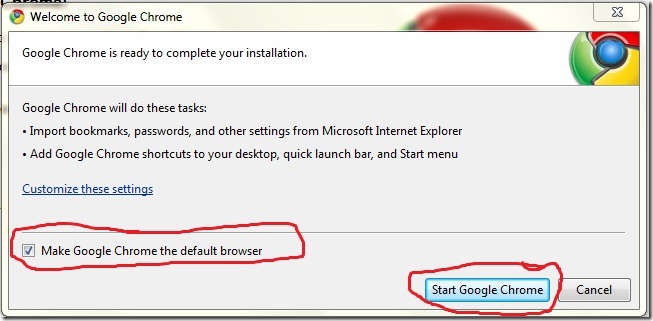
Well, what do you know?! Google has already put a check in the box to make Chrome the default browser, AND has automatically set focus to the “Start Google Chrome” button. This means, to an un-suspecting user who just keeps hitting “enter” through the wizard, they get Chrome set to the default browser! Now that’s a classic “drive-by” default setting hi-jack!
When you install Safari, like IE8, it does not ask you about default browser settings during the installation process. When you start Safari for the first time, you get the following dialog box:
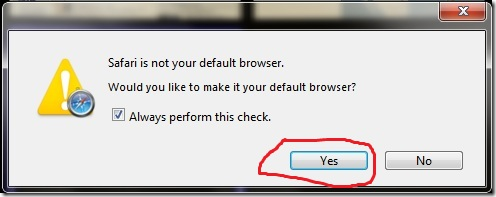
As you can see in the screen shot, if you unwittingly hit enter, the default response is “Yes” for making Safari the default. There is no check box to opt out of. In this case, you need to select “No”.
Finally, let’s take a look at Firefox:
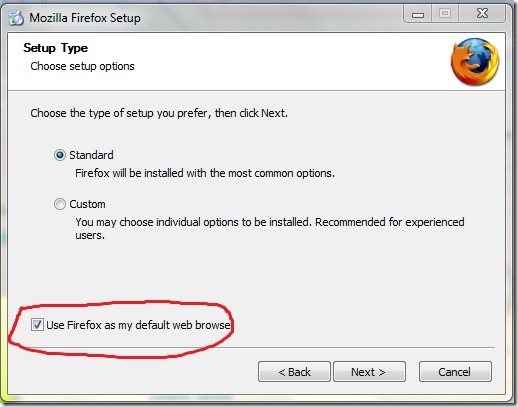
Yup, same behavior as Chrome! If I am an unsuspecting user who just hits “enter” through all the dialogs without reading, I get Firefox set as my default browser. I have to go out of my way to opt-out if I don’t want Firefox to be my default. Oh… and let’s say I choose NOT to make Firefox my default (which is what I did)… Firefox, ignores the fact that I told it I didn’t want to be my default browser and it TRIES AGAIN:

Wow! Look at that! If I accidentally click “enter” without paying attention to clear this dialog when I start Firefox for the first time, Firefox just “takes over my whole machine”.
If you look at the default installation behavior of Chrome, Safari, and Firefox compared to IE8, I think it is clear that Microsoft is going out of its way to respect the user’s default settings! The other browsers attempt to “hi-jack” your default browser settings by forcing you to ‘opt-out’ if you don’t want them to be the default. With IE8 the user has to explicitly make a choice to set the default browser. Plus, this occurs only if you actually run IE8. If you are a Firefox user and choose to install IE8 for the improved security benefits on your machine over IE6 or IE7 but never use IE8, none of your settings get changed.
That sure as hell is NOT the same old Microsoft!
Comments
Anonymous
May 03, 2009
The comment has been removedAnonymous
May 03, 2009
Not sure why you say the post is biased. It is largely objective information.Anonymous
May 04, 2009
There's one difference though. If I download and install IE8 as part of my Microsoft Update batch I treat it as just it - a security/stability update. That means, I want it to get down to my machine and lay there. With the other browsers however, I already explicitly opt-in by the sole fact of making an effort of going out to the web, finding it and downloading. Why would I do that if I don't want to use it? Why would I make the effort of getting the browser if I do not intend to use it? That's why I believe that yes by default for other browsers is a reasonable choice. This would also be true for IE if it was not a mandatory part of my system. just my $0.02Anonymous
May 04, 2009
Krzysztof Kozmic: My work machine just had IE8 installed as part of a Microsoft Update, but it did not result in IE8 taking over as the default browser. In fact, the next time I ran Internet Explorer it asked me to do the same setup at is mentioned in this article. While the default browser change can be said to be "hidden" in text if you're reaching for justifications, I think the typical user has been trained to just click "Next" without reading information during installations. Microsoft may be partly to blame for this, but sure isn't guilty of past practices in this case.Anonymous
May 04, 2009
The comment has been removedAnonymous
May 04, 2009
Found this post on twitter thanks to http://twitter.com/arcanecode Nicely done, Peter.Anonymous
May 04, 2009
The comment has been removedAnonymous
May 04, 2009
The PC World reporter is still acting like a weasel: 'Anyway, for all intents and purposes, Microsoft did "ask" before making IE8 the default browser, just not in the usual way.' "for all intents and purposes", "just not in the usual way", and of course, "ask" in scare quotes. Like some of the commenters above, he's determined to hold Microsoft to a different standard no matter what rhetorical hoops he has to jump through to do so. If Microsoft had "asked" in "the usual way" (i.e., made it really easy for the user to unsuspectingly choose IE), that certainly wouldn't mollify the critics.Anonymous
May 04, 2009
For some, no matter what, Microsoft can do nothing right. There is no convincing these people because there is no intellectual honesty on their part. Good to see Microsoft is doing the right thing here.Anonymous
May 04, 2009
If you are looking to follow this series, be sure to subscribe to my RSS feed at http://feeds.jasongaylord.com/JasonNGaylordAnonymous
May 04, 2009
Id doesn't matter what corporation is behind the browser, just make it simple and clear to use. If you can't explain how it works to an elderly relative over the phone in a few sentences, it is too difficult.Anonymous
May 06, 2009
Well done, Peter. And I would suspect like just about everything else at Microsoft, the IE team tried out various types of setup screens on sample users to see which ones were clearest to them. Also, I don't think it's just browsers. Any app that you install wants to lead you towards selecting it as the default for the task the app is meant for. I seem to recall that installing QuickTime (haven't done it in a while, so I can't confirm) makes it take over the association to MPEG files from Windows Media Player - and IIRC it doesn't ask your permission to do that.Anonymous
May 08, 2009
Peter, I can guarantee you that very few people are not going to read those seven lines of text. Users never read text and will do whateever it takes to get to the next dialog. I have seen this first hand from usability testing. This applies to any product be it Firefox or Chrome or IE. There is a better probability that users will see the one in Firefox and Chrome because it is only one item with a checkbox. I like the seperate dialog asking the user if they want to change their default browser. Maybe the dialog should always appear (and the entry removed from the 7) The UX for changing default search providers could be improved also. What is most impressive for me is the IE8 dev toolbar. Great work!